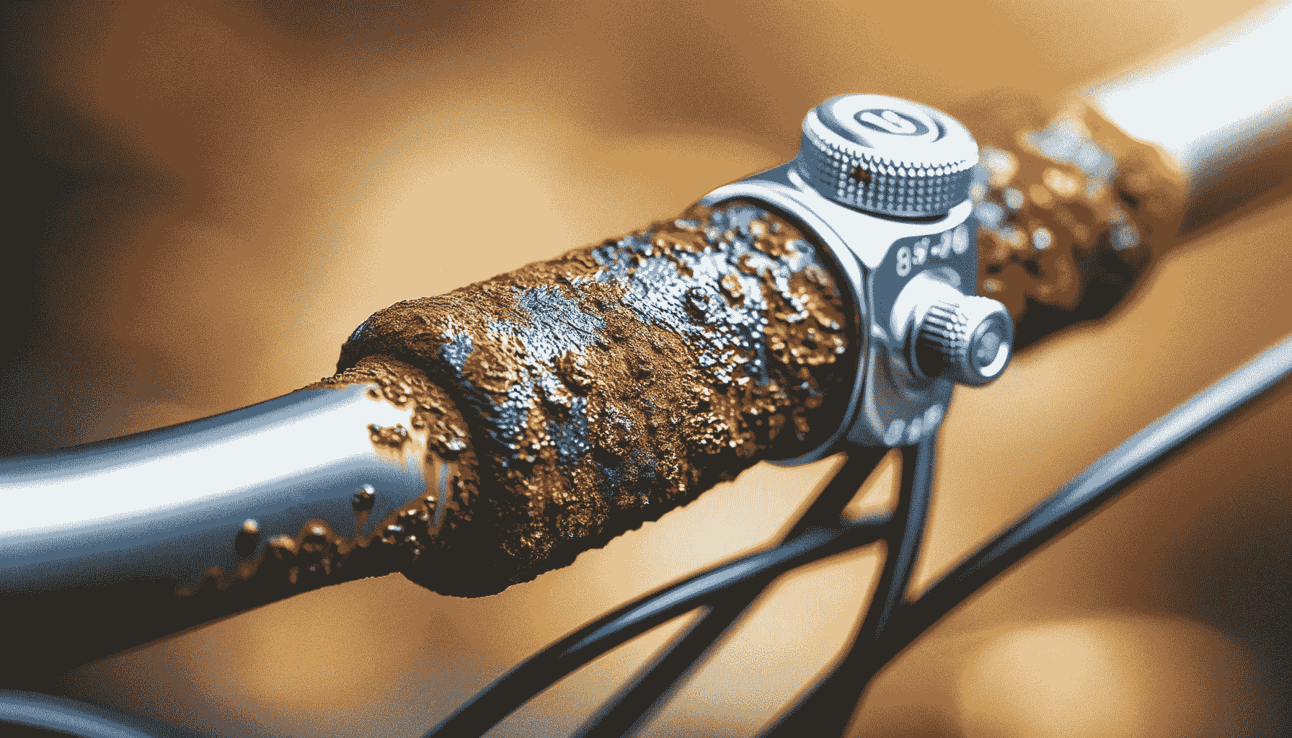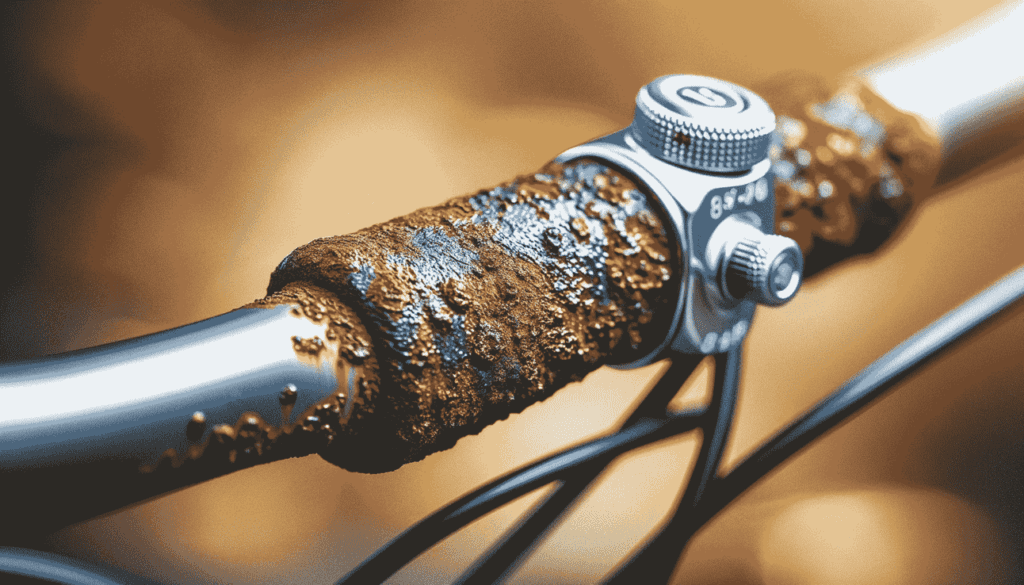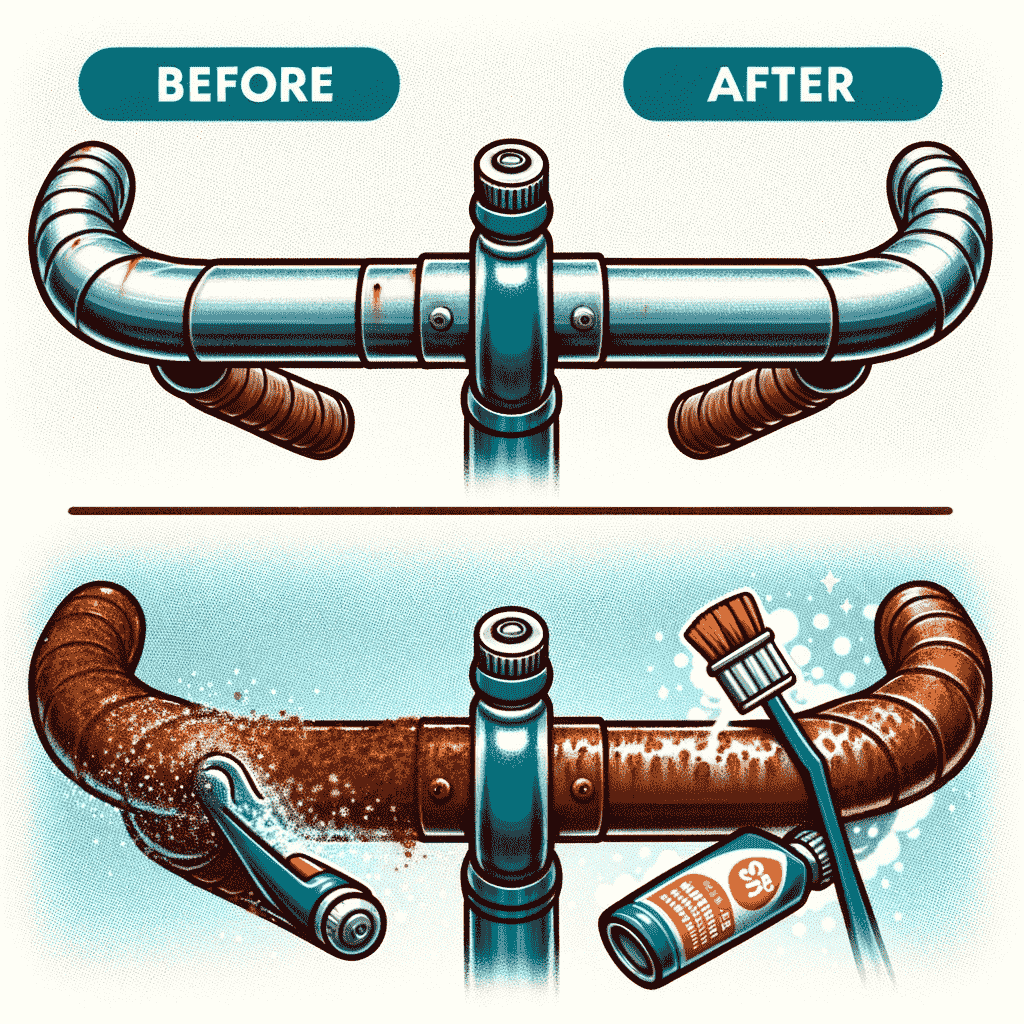
Your bicycle, a trusted companion for adventures and everyday journeys, deserves attentive care to ensure its longevity and your safety. While bike maintenance often focuses on mechanics and tires, we sometimes overlook the vital aspect of handlebar upkeep. Keeping your bike’s handlebars free of rust is not just about looks; it’s about ensuring a secure and enjoyable ride.
In this blog post, we’ll highlight the significance of rust-free handlebars and the potential safety issues posed by rusty ones. We’ll also provide you with a comprehensive guide on various methods for how to remove rust from bike handlebars. This includes using simple tools like steel wool, employing effective scrubbing techniques, and choosing appropriate cleaning agents. Whether you’re a passionate cyclist or just someone who enjoys a leisurely ride, learning how to combat rust on your handlebars effectively is a skill that every bike enthusiast should have in their repertoire.

How To Remove Rust From Bike Handlebars
Method #1: Sparkling Solution with Carbonated Drinks
Rust on your bike’s handlebars isn’t just an eyesore; it can also jeopardize your grip and safety. Thankfully, you can tackle this problem with a straightforward yet efficient method using carbonated drinks. Here’s how to do it:
What You’ll Need:
- Mild dish soap
- A soft sponge or cloth
- Carbonated soda (cola or lemon-lime soda works well)
- A bucket of warm water
- A clean, dry cloth
- Optionally: A toothbrush, baking soda paste, and fine-grit sandpaper
Step 1: Clean the Handlebars with Soap
- Mix a few drops of mild dish soap with warm water in a bucket.
- Dip a sponge or soft cloth into the soapy water and gently scrub the rusty areas on your bike’s handlebars to remove surface dirt and grime.
Step 2: Wipe the Handlebars with Soda
- Pour some carbonated soda onto a clean, dry cloth.
- Use the soda-soaked cloth to thoroughly wipe the rusted areas on your handlebars. The soda’s acidity will aid in rust removal.
Step 3: Let It Sit for a Few Minutes, Then Wipe Off
- Allow the soda to sit on the rusted spots for a few minutes, allowing it to work its magic.
- Afterward, use a clean, damp cloth or sponge to wipe away the soda residue and rust.
- If stubborn rust persists, you can gently scrub with a toothbrush or apply a baking soda paste. For more severe rust, cautiously use fine-grit sandpaper to remove it without damaging the handlebars.
This method offers an eco-friendly and budget-friendly way to effectively banish rust from your bike’s handlebars. Regular upkeep and rust prevention will keep your handlebars in top shape, ensuring a safe and pleasurable cycling experience.

Method #2: Acidic Cleaners – Your Solution to Removing Rust from Bike Parts
Dealing with rust on your bike parts, especially the handlebars, can be a daunting task. However, we have an effective method using acid-based cleaners that will help you regain the pristine condition of your bicycle. Here’s a step-by-step guide, highlighting the importance of these keywords:
Things to Prepare:
- Start by gathering essential items: mild dish soap, a sponge or soft cloth, white vinegar, and a clean, dry cloth.
- Optionally, prepare a baking soda paste to tackle stubborn rust spots.
Step 1: Clean the Handlebars with Soap
- Begin by creating a soapy solution with mild dish soap and warm water.
- Dip a sponge or a soft cloth into this soapy mixture and gently scrub the rusted areas on your bike parts. This initial cleaning is crucial for removing surface dirt and grime.
Step 2: Wipe the Handlebars with Vinegar
- Next, unleash the power of white vinegar, known for its acidity and rust-removing properties.
- Soak a clean, dry cloth in the vinegar and thoroughly wipe the rusted bike parts. The acidic vinegar is your ally in this battle against rust on a bike.
Step 3: Apply the Paste and Scrub the Rust
- Allow the vinegar to work its magic for a few minutes, breaking down the rust.
- For more stubborn rust spots, apply the baking soda paste to the affected bike parts.
- Gently scrub the rusted areas using a cloth or sponge until the rust begins to give way.
This method harnesses the rust-fighting prowess of acidic cleaners, revitalizing your bike parts and ensuring your bicycle remains in top condition. Regular upkeep and rust prevention are key to prolonging the life of your bike and ensuring that your rides remain rust-free and enjoyable.
Method #3: Rust Removal with WD-40 – A Swift Solution
Removing rust from your bicycle’s handlebars doesn’t have to be a daunting task. With the help of WD-40, you can easily dissolve rust and restore your bike’s handlebars to their former glory. Here’s a step-by-step guide, emphasizing the importance of these keywords:
Things to Prepare:
- Make sure you have WD-40, a versatile lubricant and rust dissolver, on hand.
- Gather clean cloths or rags to assist in the rust removal process.
Step 1: Assemble the WD-40
- Begin by ensuring you have a can of WD-40 readily available. Its rust-fighting properties make it a valuable tool in your rust removal arsenal.
Step 2: Spray and Wipe WD-40 on the Handlebars
- Liberally spray WD-40 onto the rusted areas of your bike’s handlebars. Be sure to cover all affected spots.
- Allow the WD-40 to penetrate and dissolve the rust for a few minutes. This versatile solution works efficiently to loosen stubborn rust.
Step 3: Wipe Off the WD-40 to Remove Rust
- Use a clean cloth or rag to wipe away the WD-40, along with the dissolved rust. You’ll notice the rust coming off, revealing cleaner handlebars underneath.
- For stubborn rust spots, consider using aluminum foil or a citric acid solution to aid in the removal process.
With the power of WD-40, you can swiftly and effectively remove rust from your bicycle’s handlebars, saving you time and effort. This method allows you to revitalize your bike’s frame and handlebars, ensuring a safe and enjoyable ride. If desired, you can even repaint the handlebars to give your bike a fresh, rejuvenated look.
Method #4: Baking Soda and Water – A Gentle Rust Remover
If you’re dealing with surface rust on your bicycle’s handlebars, a simple yet effective method using baking soda and water can help you restore them to their former glory. Here’s a step-by-step guide, emphasizing the importance of these keywords:
Things to Prepare:
- Gather mild dish soap, a sponge or soft cloth, baking soda, water, and a clean, dry cloth.
- Optionally, have a toothbrush on hand to assist in the rust removal process.
Step 1: Clean the Handlebars with Soap
- Begin by creating a soapy solution with mild dish soap and warm water.
- Dip a sponge or a soft cloth into this soapy mixture and gently clean the rusted areas on your bike’s handlebars. This initial step removes surface dirt and grime.
Step 2: Create the Baking Soda Paste
- Mix baking soda and water in equal parts to form a thick paste. For example, you can combine 1 tablespoon of baking soda with 1 tablespoon of water.
Step 3: Brush the Baking Soda Paste on the Handlebars
- Apply the baking soda paste generously onto the rusted areas of your handlebars. Ensure that the paste covers all affected spots.
Step 4: Scrub the Rust Off the Handlebars
- Allow the baking soda paste to sit on the rust for 10 to 15 minutes. You’ll notice the rust breaking down during this time.
- Using a toothbrush or a sponge, gently scrub the rusted areas to remove the loosened rust.
- Finally, wipe away the baking soda residue and any remaining rust with a clean, dry cloth.
This gentle method effectively removes surface rust from your bicycle’s handlebars, leaving them looking clean and refreshed. Regular maintenance and rust prevention will help keep your bike in top condition, ensuring enjoyable rides for years to come.
Method #5: The Power of White Vinegar – Rust Be Gone
White vinegar, a kitchen staple, can also be your go-to solution for banishing rust from your bicycle’s handlebars. Here’s a simple step-by-step guide to help you in this rust removal journey:
Materials Needed:
- White vinegar
- Water
- A clean cloth
- Optional: Gloves for hand protection
Steps:
- Mix Equal Parts White Vinegar and Water:
- Begin by mixing equal parts white vinegar and water in a bowl. This concoction will create a rust-fighting solution.
- Dip a Clean Cloth into the Vinegar Solution:
- Dip a clean cloth into the vinegar solution, ensuring it’s thoroughly soaked.
- Wring Out the Excess Liquid from the Cloth:
- Wring out the cloth to remove any excess liquid. You want it damp but not dripping.
- Apply the Vinegar Solution to the Rusted Areas of the Handlebars:
- Gently apply the vinegar solution to the rusted areas of your bike’s handlebars. Ensure that the rust is well-covered.
- Let the Vinegar Solution Sit for 15-30 Minutes:
- Allow the vinegar solution to work its magic for 15-30 minutes. During this time, it will start breaking down the rust.
- Scrub the Rusted Areas with a Clean Cloth or Non-Abrasive Sponge:
- After the waiting period, use a clean cloth or a non-abrasive sponge to scrub the rusted areas. You’ll notice the rust coming off as you scrub.
- Rinse the Handlebars with Clean Water:
- Rinse the handlebars thoroughly with clean water to remove any residual vinegar and rust particles.
- Dry the Handlebars with a Clean Cloth:
- Finally, use a clean cloth to dry the handlebars completely.
White vinegar’s acidity makes it a potent rust-fighting agent, and with this method, you can easily restore your bicycle’s handlebars to their former glory. Regular maintenance and rust prevention are key to keeping your bike in excellent condition, ensuring many enjoyable rides ahead.
Method #6: The Steel Wool Savior – Vanquishing Rust
When rust has made itself comfortable on your bicycle’s handlebars, it’s time to call in the heavy artillery: steel wool. This method will guide you on how to effectively use steel wool to remove rust and breathe new life into your handlebars:
Materials Needed:
- Steel wool (fine or medium grit)
- A clean cloth
- Optional: Gloves for hand protection
Steps:
- Wear Gloves to Protect Your Hands:
- Begin by donning gloves to protect your hands from the abrasive nature of steel wool.
- Rub the Rusted Areas with Steel Wool in a Circular Motion:
- Take the steel wool and start rubbing the rusted areas of your bike’s handlebars in a circular motion. Be gentle and apply light pressure to remove the rust without harming the handlebars.
- Wipe Away the Rust Particles with a Clean Cloth:
- As you work, you’ll notice the rust particles coming loose. Use a clean cloth to wipe them away periodically.
- Clean the Handlebars with a Damp Cloth:
- After rust removal, clean the handlebars with a damp cloth to eliminate any remaining steel wool particles. This step ensures that your handlebars are free from any abrasive residue.
- Dry the Handlebars with a Clean Cloth:
- Finally, use a clean, dry cloth to thoroughly dry the handlebars.
Steel wool is a robust rust-removal tool that can efficiently combat even stubborn rust on your bike’s handlebars. With proper care and regular maintenance, you’ll keep your bicycle looking sleek and ready for countless adventures on two wheels.
Preventing Rust on Bike Handlebars – A Guide to Long-lasting Shine
Rust can be a relentless adversary, but with the right preventive measures, you can ensure that your bike handlebars stay rust-free and gleaming for years to come. Here’s a concise guide to rust prevention:
Regular Cleaning:
- Make it a habit to clean your bike handlebars regularly with a damp cloth to remove dirt and grime. This simple step goes a long way in maintaining their luster.
Protective Coating:
- Apply a protective coating, such as wax or clear coat, to your handlebars. This shield creates a barrier that prevents rust from forming, extending the life of your handlebars.
Dry Storage:
- Store your bike in a dry place whenever possible. Moisture buildup can accelerate rust formation, so keeping your bike in a dry environment is a key preventive measure.
Additional Tips:
- For stubborn rust spots, don’t be discouraged if you need to repeat the rust removal process several times. Persistence pays off.
- In cases of severe rust, it may be necessary to replace the handlebars entirely.
- Always prioritize safety by wearing gloves when working with chemicals to protect your skin.
Conclusion: Removing rust from bike handlebars is a straightforward task that can be accomplished at home. By following the methods outlined in this guide and implementing preventive measures, you’ll ensure your bike handlebars remain clean, rust-free, and safe for countless enjoyable rides.
Can you get rust off handlebars of a bike?
Yes, you can remove rust from bike handlebars. There are various methods available, including using steel wool, white vinegar, baking soda, and commercial rust removers. The choice of method depends on the severity of the rust and your preferred approach.
Does WD-40 remove rust on bikes?
Yes, WD-40 can be an effective rust remover for bikes. It can help loosen rusted parts and make them easier to clean. However, for more stubborn rust, you may need to use additional tools or methods in combination with WD-40.
What dissolves rust on chrome?
White vinegar and aluminum foil can be used to dissolve rust on chrome surfaces effectively. Soak the rusty chrome in white vinegar, then gently rub it with crumpled aluminum foil to remove the rust.
Can you use WD-40 on a rusty bike chain?
Yes, WD-40 can be used on a rusty bike chain to help loosen rust and improve its performance. After applying WD-40, it’s essential to clean the chain thoroughly and apply a suitable bicycle chain lubricant for long-term maintenance.
How long to soak in WD-40 to remove rust?
The time needed to soak rusted parts in WD-40 can vary depending on the severity of the rust. In many cases, letting it soak for 15-30 minutes is a good starting point. However, for very stubborn rust, you may need to let it soak for several hours or even overnight for better results.
Meet Sachin Kumar, an avid cyclist and bike enthusiast with a passion for two-wheeled adventures. At our Turinbikes site, Sachin shares expert insights, thrilling ride experiences, and tips for fellow bike lovers.






